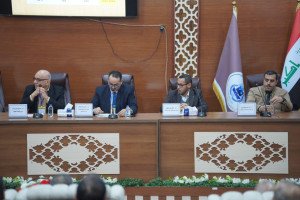
The College of Education for Pure Sciences at the University of Basrah discussed a master’s thesis entitled (Theoretical study of chemical adhesion of the quantum dot on the graphene layer)
The message presented by the researcher (Fatima Taher Hussein) included
A theoretical study of the chemical adhesion issue of a spherical semiconducting quantum dot on the graphene layer. A relationship was found to calculate occupancy numbers for the two quantitative point levels as a function of distance and temperature. Appropriate formulas for other adhesion functions were also selected, taking into consideration the effect of sham displacement and correlation, as well as using a formula for the hybridization energy as a function of distance only. The large quantitative point was considered in order to choose the type of On-Top adhesion on the graphene layer and also to choose a fixed value of the bonding energy U to be independent not dependent on twist and distance.
At room temperature T=300 K, the number of jobs and the corresponding energy levels were calculated by changing all the influences α, Vo, Edot, U, Zo separately, and then the solutions were compared with each other to choose the best values for these variables to be used in the next step, which is Study the effect of temperature. Where the following values were chosen:
The results of fixing these values at Z=0 adhesion were as follows:
, , Zch=1.6 Ao , N=0.258 , M=0
After studying the effect of the coefficients of adhesion functions and temperature, the chemical adhesion energy with its metallic and ionic molecule and the binding energy of the quantum dot on the graphene layer was calculated for two temperatures and two values of Fermi-Thomas blocking length, and it was found that the best energies values are when they are as follows:
Where the point of intersection of magnetic and non-magnetic solutions is Zch, while the point of intersection of the neutral energy curves Em and ionic energy EI is Zcros, both of which are considered important results of the chemical adhesion theory.
Aim of the study:
Chemical adhesion is one of the most important methods for studying chemical reactions on material surfaces, in other words, determining the dependence of adherent structures on surface properties in terms of crystal structure, purity, concentration of impurities and external influences, and linking the adhesion process to surface properties due to the importance of the subject in many applications, including, approved devices On single-electron transistors or light-emitting diodes, commonly known as LEDs, second harmonic generation in quantum computing, medical development and promising applications in nanoelectronics, bioelectronics, gas sensors, hydrogen storage devices, diodes and organic displays, biological and chemical sensors, solar cells and fuels.








